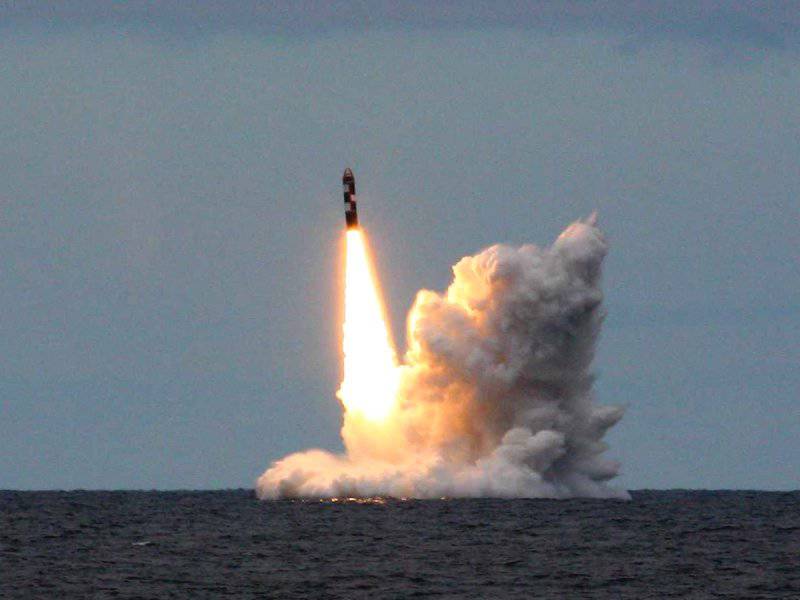Test launches missiles "Bulava" and "Sinev"
October 29 nuclear submarine "Yuri Dolgoruky" (project 955 "Borey"), being in the waters of the Barents Sea, from a submerged position launched a ballistic missile "Bulava". The rocket successfully completed its flight mission and delivered training combat units to the Kura (Kamchatka) test site, where training objectives were conditionally hit. This launch of the Bulava from Yuri Dolgoruky has several interesting features. So, it was carried out as part of the combat training program for the submarine crew. Also for the first time in stories submarine project 955 submarine missile carrier received a full set of missiles "Bulava". The submarine launchers were immediately 16 missiles, one of which was launched.
November 5 submariners of the Northern Fleet once again completed the training launch of the rocket. This time the task was to launch the crew of the submarine "Tula" (project 667BDRM "Dolphin"). On board this submarine, which was underwater, was launched rocket "Sineva". The purpose of the start was the conditional defeat of training goals at the Kura training ground. At the appointed time, all training warheads arrived at the site. Start was recognized as successful.
On November 1, the Strategic Missile Forces joined the Navy. On this day, an intercontinental ballistic missile Topol-M was launched at one of the sites of the Plesetsk test site. According to some reports, 1 November was the first test launch of the rocket since December 2004, i.e. from the tests of the mobile version of the complex. Like other recent tests, the Topol-M rocket launch ended with a successful defeat of training targets at the Kura test site.
In the context of the latest ballistic missile test launches, we should also recall the events of September 10 of the year 2014. Then, carrying out the test program, the submarine Vladimir Monomakh (project 955) launched the Bulava R-30 rocket at targets at the Kura test site. Successful launch allowed to continue testing. At the end of October, it was reported that the Sevmash enterprise, which had built a submarine, was preparing for its transfer to the customer.
Earlier it was reported that another launch of the Bulava rocket will be carried out this fall. However, recently there was a new information about the plans of the military regarding the tests of this missile complex. On November 10, the Interfax news agency, citing an unnamed source in the defense industry, reported that the Bulava missiles would not be tested in the coming months. Currently, experts are working on a schedule of launches next year. In accordance with the already defined plans, the next launch of the P-30 rocket will take place only in the fall of 2015. The launch will be carried out by the Alexander Nevsky submarine.
The P-30 “Bulava” and P-29RMU2 “Sineva” missile test launches, among other things, are designed to test and demonstrate the capabilities of the naval component of strategic nuclear forces. "Mace" and "Sineva" are currently the only ballistic missiles for submarines, which are in service with the Russian Navy and should gradually oust outdated products of the P-29 family. Rocket R-29RMU2 is designed to improve the combat performance of the submarines project 667BDRM. There are six such submarines in the formation, each of which is capable of carrying 16 Sinev missiles.
The Sinev missile was created on the basis of the P-29РМ project. In order to upgrade the armament of strategic submarine missile carriers in the late nineties, the creation of a modernized version of the existing missile began. Work on the project Р-29РМУ2 lasted until the middle of the two thousandth. The launch of the Sinev missile has been carried out since 2004. The submarines-carriers of this missile received a number of new equipment necessary for its operation within the framework of medium repair.
To date, the navy has only three submarines capable of carrying the Bulava R-30 missiles. These are the submarine cruisers “Yuri Dolgoruky” and “Alexander Nevsky” of the 955 project, and also the “Dmitry Donskoy” of the 941UM project. In the foreseeable future, the transfer of the third boat "Borey" - "Vladimir Monomakh". In total, 2020 plans to build 8 submarines of this type by year. Each of the submarines of the 955 project carries on 16 P-30 missiles. Thus, in the foreseeable future, the boats of the 955 and 667БДРМ projects should become the basis of the sea component of the nuclear triad, displacing the outdated submarines of the 667БДР project.
The latest launches of the P-30 and P-29RMU2 missiles are the next steps in the program to upgrade the strategic nuclear forces and the navy. Of particular interest in this context is the launch of the Bulava from the submarine Yuri Dolgoruky, equipped with full ammunition. In the future, such tests should continue. According to the latest data, the new launch of the P-30 rocket will be held next autumn.
On the materials of the sites:
http://ria.ru/
http://interfax.ru/
http://itar-tass.com/
http://rg.ru/

Information